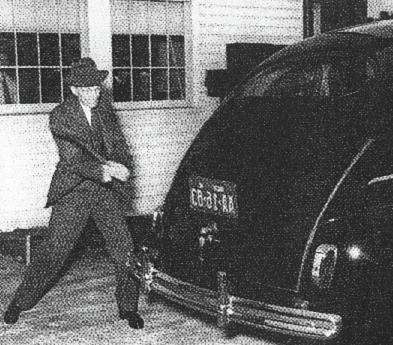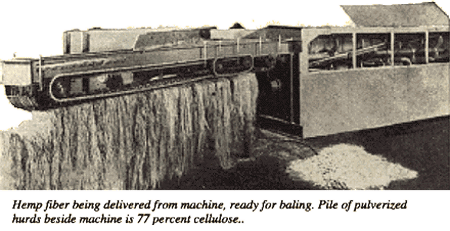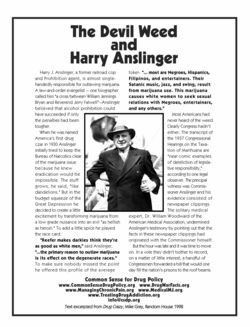Source: obrag.org

Henry Ford demonstrates the strength of his car “grown” from a
combination of hemp and other annual crops, and designed to
run on hemp fuel, by smashing it with a crowbar.
(Popular Mechanics, 1941)
I must admit, when I first read about Henry Ford’s automobile made solely from hemp products the first image that popped into my head was of Cheech & Chong’s van made of marijuana (complete with Thai sticks for bumpers) from the 1978 movie titled “Up in Smoke.”
Strangely, my life was never quite the same after that movie came out. But that’s a whole ‘nuther story. lol (more about Henry Ford’s hemp car later)
A new theory has been posited about the origin of the prohibition of hemp in America. Like many other people, I had always subscribed to the conventional theory that it was the dirty deeds of turn of the [20th] century oligarchs like William Randolf Hearst and the DuPont family who were mainly (or at least financially) responsible for the demise of the hemp industry — due to the threat hemp posed to their respective commodity empires — i.e., lumber and paper, and textiles and chemicals. (link to DuPont company history here)
Turns out, that accepted theory may no longer be acceptable.
The history of the hemp plant and it’s truncated industry in the United States has been long and storied. Hemp’s nearly limitless industrial versatility was once widely thought to be America’s new economic engine for growth. In fact, the magazine Popular Mechanics even dubbed the hemp plant, America’s “New Billion Dollar Crop” in a cover story from an issue back in 1938.
Hmm, I wonder what that billion dollar crop would be worth in today’s standard, factoring in, of course, innovation, financial investments, and a steady progression of applicable technological advances since the early 20th Century.
So, what the hell happened?
From the Popular Mechanics article: (via the Northern Wisconsin Chapter of NORML)
American farmers are promised a new cash crop with an annual value of several hundred million dollars, all because a machine has been invented which solves a problem more than 6,000 years old. It is hemp, a crop that will not compete with other American products. Instead, it will displace imports of raw material and manufactured products produced by underpaid coolie and peasant labor and it will provide thousands of jobs for American workers throughout the land.
The machine which makes this possible is designed for removing the fiber-bearing cortex from the rest of the stalk, making hemp fiber available for use without prohibitive amounts of human labor.
Hemp is the standard fiber of the world. It has great tensile strength and durability. It is used to produce more than 5,000 textile products, ranging from rope to fine laces, and the woody “hurds” remaining after the fiber has been removed contain more than seventy-seven per cent cellulose, and can be used to produce more than 25,000 products, ranging from dynamite to Cellophane.

NW Wisc. NORML
But just how easy is the crop grown?
From the farmers’ point of view, hemp is an easy crop to grow and will yield from three to six tons per acre on any land that will grow corn, wheat, or oats. It can be grown in any state of the union. It has a short growing season, so that it can be planted after other crops are in. The long roots penetrate and break the soil to leave it in perfect condition for the next year’s crop. The dense shock of leaves, eight to twelve feet above the ground, chokes out weeds. Two successive crops are enough to reclaim land that has been abandoned because of Canadian thistles or quack grass.
So, basically (and illogically, imo) hemp prohibition came about in the U.S. despite the plant’s well-documented eco-friendly, versatility; its wide availability, and its relatively simple, inexpensive growth and production processes. Go figure.
From Alternet:
For farmers, an alternative to taking land out of production and destroying “surplus” commodities would have been to plant crops they could market profitably. Thanks to advances in chemistry, there was at this time a rising “chemurgy” movement that Morgenthau, a farm expert, would certainly have known about. Chemurgy involves growing crops not for food but for transformation into various industrial products—plastics, coatings, thread, etc. As Dave West puts it, chemurgy is based on “the idea that anything you can make from a hydrocarbon you can make from a carbohydrate… Rayon from plants instead of nylon from petroleum.” Henry Ford was a leading proponent of chemurgy. Ford had his workers build a car out of hemp-based products and arranged for a promotional photo of himself, in an overcoat and hat, bashing the rear fender with a sledgehammer to show how strong the material was. (my emphasis)
Simply amazing
But on to the new theory…
During the FDR administration, in 1937, a racist, Harry Anslinger, was the longtime commissioner of the Federal Bureau of Narcotics. He was widely considered the prime mover behind marijuana prohibition. But during the congressional debate on the subject, Anslinger was just one witness in a strange show trial.
He testified that marijuana induces homicidal mania and so forth, but it was not Anslinger who designed the complicated prohibitive-tax strategy. That maneuver was thought up by the Treasury Department’s top lawyer, Herman Oliphant. Nor was Anslinger called back to refute William Woodward of the American Medical Association, who argued that a federal prohibition was uncalled for.
Note: it’s important to explain the reason I called Anslinger a racist. He was infamous for hismisguided disgusting and bigoted quotes of the era. Why FDR ever picked this guy is beyond me. But they are what they are. And he was what he was.
 “Reefer makes darkies think they’re as good as white men,” said Anslinger. “The primary reason to outlaw marijuana is the effect it has on the degenerative races.”
“Reefer makes darkies think they’re as good as white men,” said Anslinger. “The primary reason to outlaw marijuana is the effect it has on the degenerative races.”
To make sure no one missed his point, Anslinger went on to offer a profile of the average marijuana toker.
“Most are Negroes, Hispanics. Filipinos and entertainers. Their satanic music, jazz and swing, result from smoking marijuana. This marijuana makes White women to seek sexual relations with Negroes, entertainers, and any others.”
As it turns out, it was Congressman Fred Vinson of Kentucky who dealt with Woodward, subjecting him to a snide, relentless grilling.
In the transcript of the hearing, Vinson comes across as an effective prosecutor committed to getting the prohibitive-tax bill enacted, while Anslinger seems like a carnival pitch man—yowza, yowza, yowza. Both men were carrying water for the Treasury Department, which had drafted the prohibition bill and was asking Congress to impose it on the nation.When the final curtain fell in my imaginary drama, the actual villain seemed to be Vinson, not Anslinger. As I was mulling over the implications, Dave West referred me to his eye-opening essay, “Low, Dishonest Decade,” published in 1999. West, who has a PhD in plant breeding and genetics, spent most of his career as a geneticist/breeder of “corporate maize” (his term). He pioneered the application of molecular markers in crop breeding.
In his essay, West argues that Anslinger did not push through federal legislation to enact prohibition with backing from Hearst, DuPont and Andrew Mellon. (the DuPont’s banker, Republican Secretary of the Treasury from 1921 to 1933, and the man who appointed Anslinger to run the Federal Bureau of Narcotics in 1930)
However…
A conspiracy involving Hearst, Du Pont and Mellon was posited by Jack Herer, the man who in the 1980s discovered the suppressed history of hemp, its multiple uses and its economic potential. Herer shared his findings in a collage of documentation called The Emperor Wears no Clothes. Herer’s admirers should be open-minded about West’s take on the federal prohibition. Herer’s revelations and accomplishments are of an order of magnitude that won’t be reduced if his theory of three rich Republicans masterminding prohibition doesn’t pan out.
Alternatively, West suggests a leadership role in the prohibition of hemp for Henry Morgenthau, Jr., FDR’s secretary of the Treasury from 1934 to 1945. (After FDR died, Harry Truman replaced Morgenthau with the above-mentioned Fred Vinson.)
Morgenthau was well aware of the Nazi threat and the strong isolationist sentiment that could keep the administration from intervening on behalf of European Jews. He was tracking the expanding network of Nazi front groups in this country, and the German-American Bund. There were German-American hemp farmers in contact with Henry Ford, a leading anti-Semite. Morgenthau must have suspected they were associated with the Bund and wanted to keep tabs on them. As secretary of the treasury, Morgenthau was in charge of the Federal Bureau of Narcotics, which had law-enforcement and domestic-surveillance capabilities. Its commissioner, Harry Anslinger, was an ambitious bureaucrat out to maximize his agency’s power. West’s theory is that Morgenthau orchestrated the federal prohibition and that Anslinger’s railing against marijuana was part of the play.
It is logical that the head honcho called the shots. In an interview in 1970, Anslinger himself told David Musto that Morgenthau wanted the ban in response to pressure from law enforcement in several states. But Morgenthau never wanted those reasons to become public information. The Treasury Department oversaw the entire process, according to the transcript of a congressional hearing on prohibition.
In a paper on the 1937 Marijuana Tax Act that ran in the Archives of General Psychiatry (and was reprinted by Tod Mikuriya in Marijuana Medical Papers), Musto wrote, “The hearings before the House were held in late April and early May. They were curious events. The Treasury’s presentation to Congress has been adequately described many times, although no retelling has equaled reading the original transcript.”
Herbert Levy’s 2010 biography of Morgenthau Henry Morgenthau, Jr.: The Remarkable Life of FDR’s Secretary of the Treasury by Herbert Levy (Skyhorse Publishing, 2010) seems to indicate at least indirect support for West’s hypothesis regarding Morgenthau as the prime motivator behind the federal ban on hemp and marijuana that stills stands to this day.
To me, this is sheer madness. Hemp (and all its byproducts) has the potential to be the biggest driver of a boom economy we’ve seen in this country in decades, if not centuries. Every aspect of its versatility is far superior to the corresponding alternatives were using now. Industrialized, together, — hemp and its intoxicating cousin marijuana — could improve our lives in many, many ways, potentially creating millions of jobs as well.
And the life improvements also pertain to recreational use:

What a waste
Please, there’s much more to the story @ Alternet – Who Orchestrated the Prohibition of Marijuana? Originally posted at Daily Kos
No comments:
Post a Comment